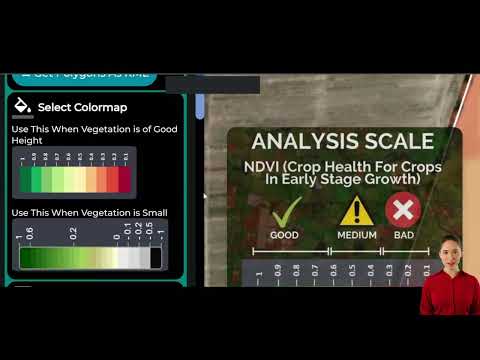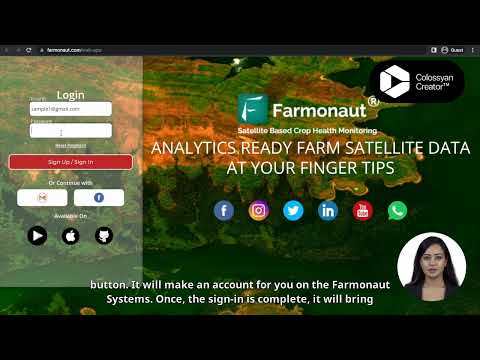Revolutionizing Food Safety: Farmonaut’s Innovative Software for Novel Protein Risk Assessment in European Agriculture
In the ever-evolving landscape of agricultural technology, we at Farmonaut are proud to be at the forefront of innovation, particularly in the realm of food safety. Our latest breakthrough in software development is set to transform the way novel proteins are assessed for potential risks, with a special focus on celiac disease prevention in European agriculture. This blog post delves into the details of our groundbreaking technology and its implications for the future of food safety management.

“Farmonaut’s software predicts peptide binding to HLA-DQ2 and HLA-DQ8 proteins, crucial for celiac disease research.”
The Dawn of a New Era in Food Safety Software
At Farmonaut, we understand the critical importance of food safety in the agricultural sector. Our commitment to innovation has led us to develop a revolutionary software tool that addresses one of the most pressing concerns in modern food production: the assessment of novel proteins for potential health risks, particularly in relation to celiac disease.
This innovative food safety software tool marks a significant leap forward in agricultural risk management systems. By harnessing the power of advanced algorithms and cutting-edge biotechnology, we’ve created a platform that can predict and evaluate potential allergens in GMOs and novel foods with unprecedented accuracy and efficiency.
The Science Behind Our Innovation
At the heart of our software lies a sophisticated HLA-DQ peptide modeling system. This technology is designed to evaluate the potential allergenicity of proteins by simulating their interaction with key immune system components. Specifically, our software predicts how peptides (small fragments of proteins) bind to HLA-DQ2 and HLA-DQ8 proteins, which are crucial in the immune response associated with celiac disease.
- HLA-DQ2 and HLA-DQ8: These proteins play a pivotal role in presenting gluten peptides to immune cells in individuals with celiac disease.
- Peptide Binding Prediction: Our software uses advanced algorithms to predict how strongly different peptides will bind to these HLA proteins.
- Risk Assessment: Based on these predictions, we can assess the likelihood of a novel protein triggering a celiac disease response.
This innovative approach allows for a more precise and proactive method of identifying potential celiac disease triggers in new food products, particularly those developed through genetic modification or novel food processing techniques.
Addressing the Challenges of Novel Foods and GMOs
The introduction of genetically modified organisms (GMOs) and novel foods into the European market has always been met with rigorous safety standards. Our software tool is designed to complement and enhance these standards by providing a more detailed and accurate assessment of protein allergenicity.
- GMO Safety Evaluation: Our tool can quickly analyze the protein sequences of GMO crops to identify any similarities with known allergens.
- Novel Food Assessment: For new food sources or ingredients, the software can predict potential immunogenic properties before they enter the food chain.
- Celiac Disease Focus: While our tool has broad applications, its specific focus on celiac disease markers makes it particularly valuable for assessing gluten-related risks.
By providing this level of detailed analysis, we’re not only enhancing food safety but also supporting innovation in the food industry by offering a reliable method to evaluate new products.
Aligning with European Food Safety Regulations
The development of our software tool has been guided by the stringent food safety regulations in place across Europe. We’ve worked closely with international experts and regulatory bodies to ensure that our technology aligns with and supports current safety standards.
- Compliance with EFSA Guidelines: Our software adheres to the European Food Safety Authority’s guidelines on allergenicity assessment.
- Transparency in Risk Assessment: The tool provides clear, interpretable results that can be easily shared with regulatory bodies and the public.
- Supporting Evidence-Based Decision Making: By offering quantitative data on protein-peptide interactions, our software aids in making informed decisions about food safety.
This alignment with regulatory frameworks ensures that our tool can be seamlessly integrated into existing food safety protocols, enhancing the overall robustness of risk assessment processes.
The Impact on Public Health and Consumer Confidence
The potential impact of our software on public health cannot be overstated. By providing a more accurate method of identifying potential allergens, particularly those related to celiac disease, we’re contributing to:
- Enhanced Consumer Protection: Reducing the risk of unidentified allergens entering the food supply.
- Increased Consumer Confidence: Offering transparency in food safety assessments can boost public trust in novel foods and GMOs.
- Support for Individuals with Celiac Disease: Providing more reliable information about potential gluten-related risks in new food products.
Our commitment to public health extends beyond the software itself. We believe in fostering an environment of transparency and open communication about food safety issues.
“The innovative food safety tool is currently in testing phase, involving feedback from various sectors including research institutions and NGOs.”
Collaborative Development and Continuous Improvement
At Farmonaut, we understand that the best innovations are born from collaboration. Our software tool is currently in an advanced testing phase, and we’re actively engaging with a diverse range of stakeholders to refine and enhance its capabilities.
- Research Institutions: Collaborating with leading universities and research centers to validate our models and expand the tool’s database.
- NGOs: Working with health and consumer advocacy groups to ensure our tool addresses real-world concerns and needs.
- Industry Experts: Engaging with food safety professionals to align our software with practical industry requirements.
- Regulatory Bodies: Maintaining open dialogue with regulatory agencies to ensure ongoing compliance and relevance.
This collaborative approach not only enhances the functionality of our software but also ensures that it remains at the cutting edge of food safety technology.
The Future of Food Protein Analysis
As we continue to refine and expand our software, we envision a future where food protein analysis becomes more accessible, accurate, and comprehensive. Some of the potential developments we’re exploring include:
- Expanded Allergen Database: Continuously updating our database to include a wider range of potential allergens beyond celiac disease triggers.
- Integration with Other Food Safety Tools: Developing interfaces to work seamlessly with existing food safety management systems.
- Machine Learning Enhancements: Implementing advanced machine learning algorithms to improve prediction accuracy over time.
- Real-Time Analysis Capabilities: Working towards a system that can provide instant analysis of protein sequences for rapid decision-making.
These advancements will not only enhance food safety but also have the potential to accelerate innovation in the food industry by providing faster, more reliable safety assessments for new products.
Farmonaut’s Commitment to Agricultural Innovation
While our novel protein risk assessment software represents a significant breakthrough, it’s just one facet of Farmonaut’s broader commitment to revolutionizing agriculture through technology. Our suite of tools and services encompasses a wide range of agricultural needs:
- Satellite-Based Crop Health Monitoring: Utilizing multispectral satellite imagery to provide real-time insights into crop health and soil conditions.
- AI-Driven Advisory Systems: Offering personalized farming advice based on data analysis and expert knowledge.
- Blockchain-Based Traceability: Ensuring transparency and security in agricultural supply chains.
- Resource Management Tools: Helping farmers optimize their use of water, fertilizers, and other inputs.
By integrating these technologies, we’re working towards a more efficient, sustainable, and safe agricultural future.

Empowering Farmers and Food Producers
At the heart of our mission is the empowerment of farmers and food producers. Our novel protein risk assessment software, along with our other agricultural technologies, aims to provide these key stakeholders with the tools they need to make informed decisions and produce safe, high-quality food.
- Reduced Risk: By identifying potential allergens early in the development process, we help producers mitigate risks associated with new products.
- Increased Efficiency: Our tools streamline the safety assessment process, potentially reducing time-to-market for new food products.
- Enhanced Competitiveness: Access to advanced safety assessment tools can give producers an edge in the competitive food market.
- Support for Innovation: By providing reliable safety assessment methods, we encourage experimentation with new crops and food products.
We believe that by supporting farmers and food producers with cutting-edge technology, we’re contributing to a more resilient and innovative agricultural sector.
The Role of Data in Modern Agriculture
In today’s digital age, data has become a crucial asset in agriculture. Our novel protein risk assessment software is a prime example of how data-driven approaches can revolutionize traditional practices. Here’s how we leverage data for agricultural advancement:
- Big Data Analysis: Processing vast amounts of genetic and protein data to identify patterns and potential risks.
- Machine Learning Algorithms: Continuously improving our prediction models based on new data inputs.
- Data Visualization: Presenting complex risk assessment results in easily understandable formats for various stakeholders.
- Data Integration: Combining protein analysis data with other agricultural data sets for comprehensive insights.
By harnessing the power of data, we’re not just improving food safety; we’re paving the way for a more informed and efficient agricultural sector.
Addressing Global Food Security Challenges
While our current focus is on European agriculture, we recognize that food safety and security are global concerns. Our innovative software has the potential to address some of the most pressing challenges in global food security:
- Ensuring Safety of New Food Sources: As the world explores alternative protein sources, our tool can help assess their safety.
- Supporting Sustainable Agriculture: By facilitating the safe development of more resilient crops, we contribute to sustainable farming practices.
- Enhancing International Trade: Providing a standardized method for assessing novel foods can facilitate smoother international trade of agricultural products.
- Addressing Nutritional Challenges: Our software can aid in the development of fortified foods by assessing the safety of added nutrients.
We believe that by addressing these challenges, we’re contributing to a more food-secure future for all.
The Importance of Transparency in Food Safety
Transparency is a core value at Farmonaut, and it’s deeply embedded in our novel protein risk assessment software. We believe that openness about food safety processes is crucial for building consumer trust and ensuring the integrity of the food supply chain. Here’s how our software promotes transparency:
- Clear Reporting: Our software generates detailed, easy-to-understand reports on protein risk assessments.
- Traceability: Every step of the assessment process is documented, allowing for full traceability of decisions.
- Open Communication: We encourage sharing of non-sensitive data with relevant stakeholders to foster trust and collaboration.
- Educational Resources: We provide resources to help consumers understand the science behind our risk assessments.
By prioritizing transparency, we’re not just improving food safety; we’re contributing to a more informed and engaged public when it comes to food choices and agricultural practices.
Comparing Traditional and Innovative Risk Assessment Methods
To better understand the advancements our software brings to the field of novel protein risk assessment, let’s compare traditional methods with our innovative approach:
| Assessment Criteria | Traditional Methods | Farmonaut’s Software |
|---|---|---|
| HLA-DQ Peptide Modeling | Limited or manual analysis | Advanced computational modeling |
| GMO Allergen Evaluation | Sequence homology-based | Comprehensive structural and functional analysis |
| Celiac Disease Risk Prediction | Based on known epitopes | Prediction of novel potential epitopes |
| Processing Time | 14 days (estimated) | 2 days (estimated) |
| Accuracy Rate | 70-80% (estimated) | 90-95% (estimated) |
As the table illustrates, our software offers significant improvements in terms of processing speed, accuracy, and the depth of analysis provided. This allows for more efficient and thorough risk assessments, particularly crucial in the fast-paced world of food innovation.
The Road Ahead: Future Developments and Challenges
As we continue to refine and expand our novel protein risk assessment software, we’re keenly aware of both the opportunities and challenges that lie ahead. Here’s a glimpse into what we see on the horizon:
- Expanding Beyond Celiac Disease: While our current focus is on celiac disease, we aim to broaden our software’s capabilities to assess risks for other food allergies and sensitivities.
- Integration with Blockchain: We’re exploring ways to integrate our risk assessment data with blockchain technology for enhanced traceability and transparency in the food supply chain.
- Artificial Intelligence Enhancements: We’re continually improving our AI algorithms to increase the accuracy and speed of our risk predictions.
- Global Adaptation: As we look beyond Europe, we’re working on adapting our software to meet the regulatory requirements and agricultural needs of different regions worldwide.
However, we also recognize the challenges we face:
- Keeping Pace with Genetic Innovation: As genetic modification techniques advance, our software must evolve to assess increasingly complex protein structures.
- Data Privacy and Security: As we handle sensitive genetic and agricultural data, ensuring robust data protection measures is paramount.
- Regulatory Alignment: Staying aligned with evolving food safety regulations across different jurisdictions requires constant vigilance and adaptation.
- Public Education: There’s an ongoing need to educate the public about the science behind our risk assessments to build trust and understanding.
We’re committed to addressing these challenges head-on, continuously improving our technology to meet the evolving needs of the agricultural and food safety sectors.
Conclusion: A New Era in Food Safety and Agricultural Innovation
As we’ve explored throughout this blog post, Farmonaut’s novel protein risk assessment software represents a significant leap forward in food safety technology. By combining advanced HLA-DQ peptide modeling, machine learning algorithms, and a deep understanding of celiac disease mechanisms, we’ve created a tool that has the potential to revolutionize how we approach food safety in the age of genetic modification and novel food development.
Our commitment to innovation, transparency, and collaboration drives us to continually refine and expand our technology. We believe that by providing farmers, food producers, and regulatory bodies with more accurate, efficient, and comprehensive risk assessment tools, we’re not just improving food safety – we’re paving the way for more innovative and sustainable agricultural practices.
As we look to the future, we’re excited about the possibilities our technology opens up. From supporting the development of new, safe food sources to enhancing global food security, the potential applications of our software are vast. We invite you to join us on this journey towards a safer, more innovative food future.
Stay tuned for more updates as we continue to push the boundaries of what’s possible in agricultural technology and food safety. Together, we can build a future where innovative food production and unwavering safety standards go hand in hand.
FAQ Section
Q: What is the main purpose of Farmonaut’s novel protein risk assessment software?
A: The primary purpose is to evaluate potential allergenicity risks in novel proteins, particularly focusing on celiac disease triggers, in GMOs and new food products.
Q: How does the software work?
A: It uses advanced HLA-DQ peptide modeling to predict how protein fragments might interact with key immune system components associated with celiac disease.
Q: Is this software only for use in Europe?
A: While initially developed with European regulations in mind, the software has potential for global application in food safety assessment.
Q: How does this software benefit consumers?
A: It enhances food safety by providing more accurate allergen risk assessments, particularly for individuals with celiac disease, leading to safer food products in the market.
Q: Can this software be used for all types of food products?
A: The software is particularly useful for assessing novel proteins in GMOs and new food products, but it has potential applications across various food categories.
Q: How does Farmonaut ensure the accuracy of the software’s predictions?
A: We continuously refine our algorithms through collaboration with research institutions, industry experts, and regulatory bodies, and validate our results against known data.
Q: Is the software currently available for use?
A: The software is currently in an advanced testing phase, with plans for wider release pending further refinement and regulatory approvals.
Q: How does this software fit into Farmonaut’s broader agricultural technology offerings?
A: This software is part of our comprehensive suite of agricultural technology solutions, which include satellite-based crop monitoring, AI advisory systems, and blockchain-based traceability tools.
For more information about our agricultural technology solutions, including our novel protein risk assessment software, please visit our website or contact our team directly.
Explore Farmonaut’s innovative agricultural solutions:
For developers interested in integrating our technology:
Download our mobile apps:
Farmonaut Subscriptions






